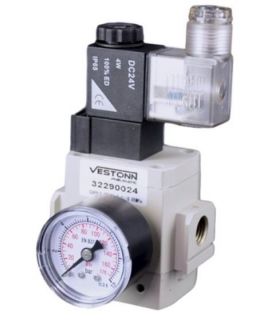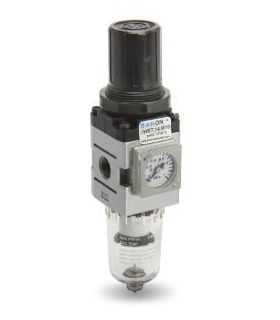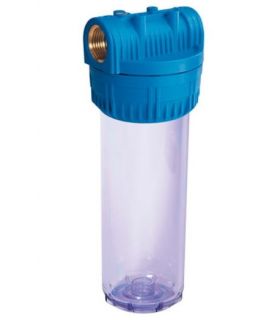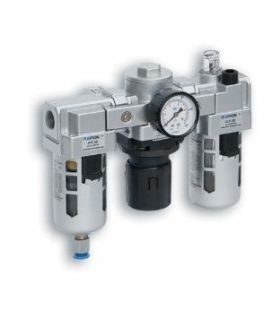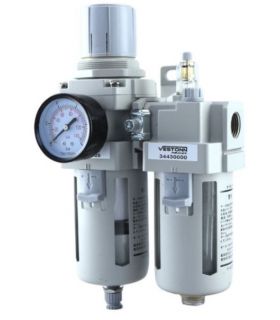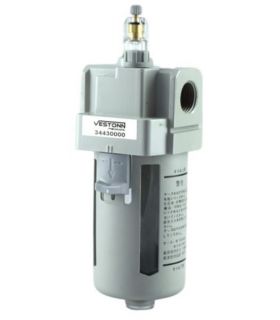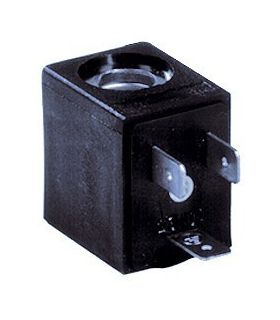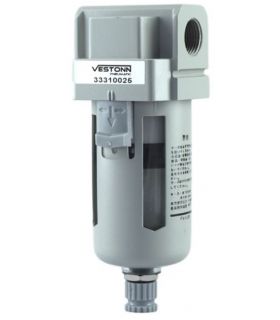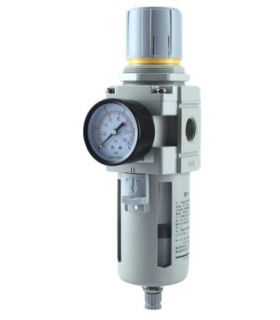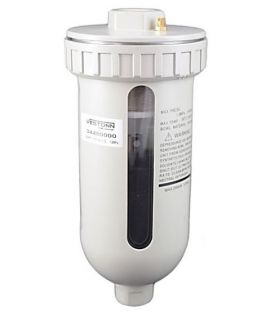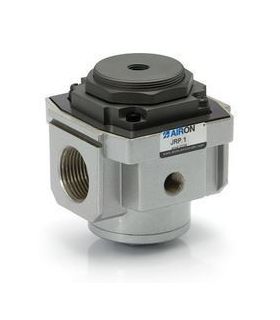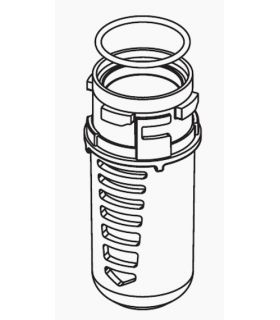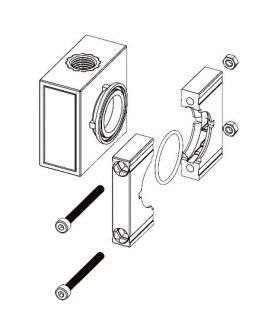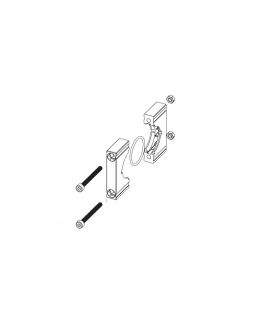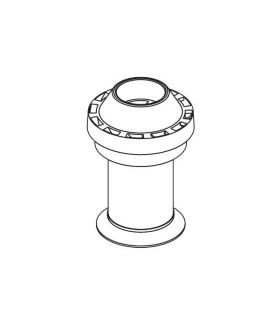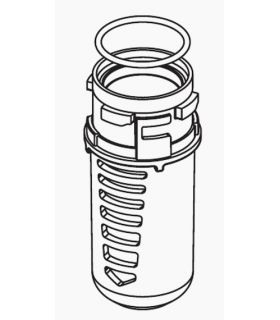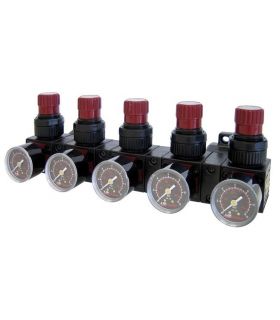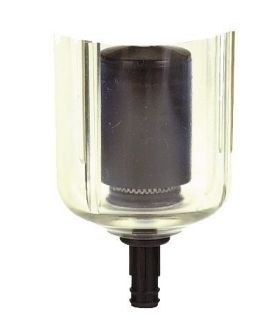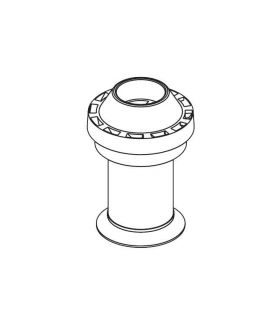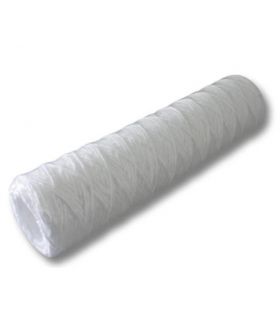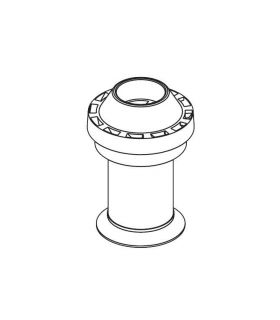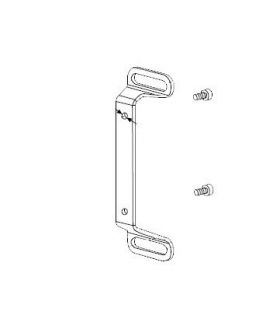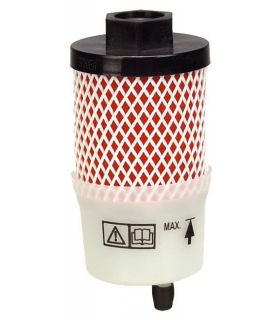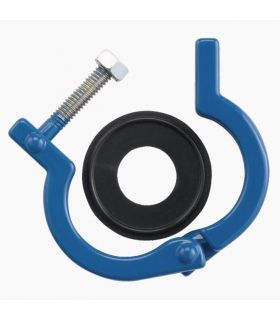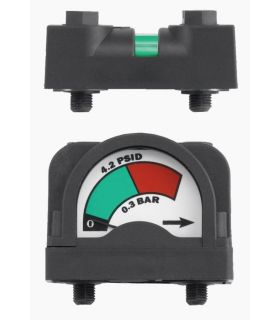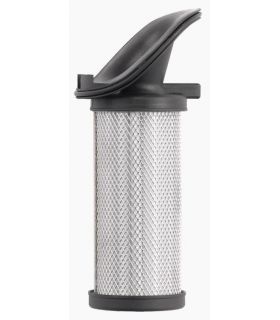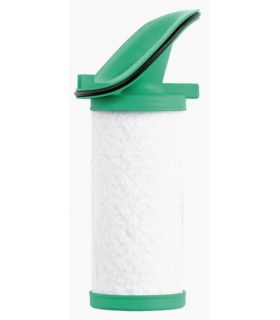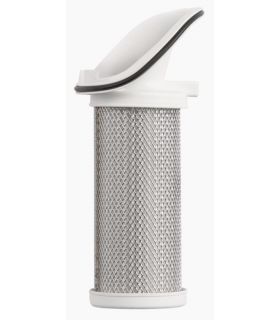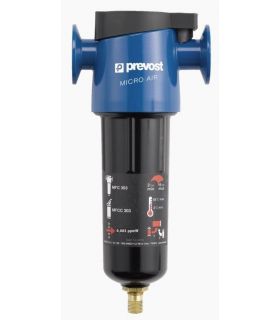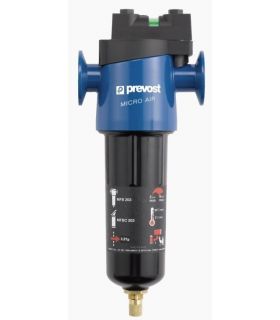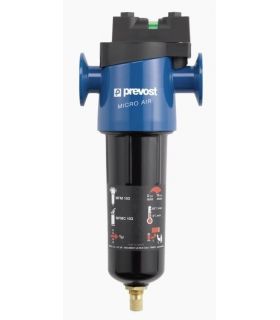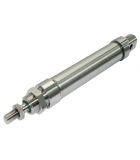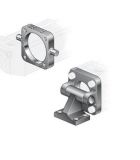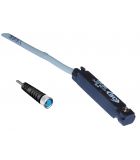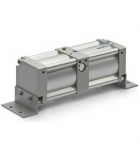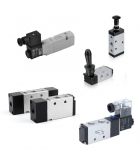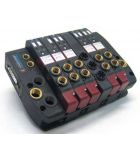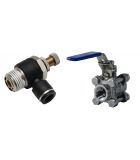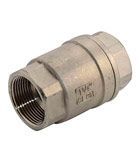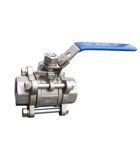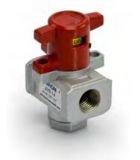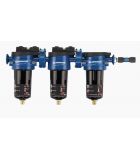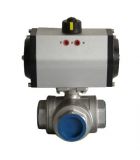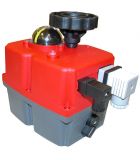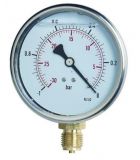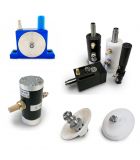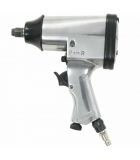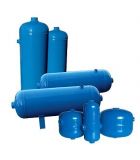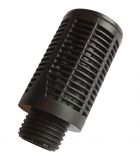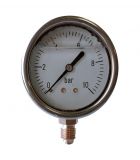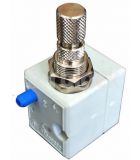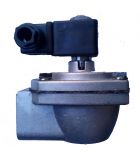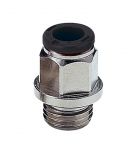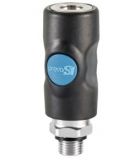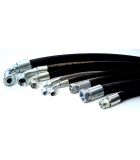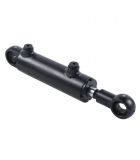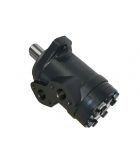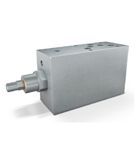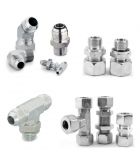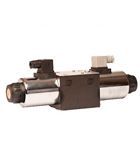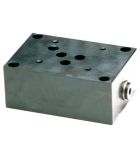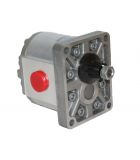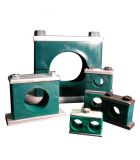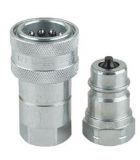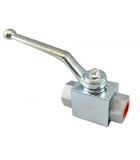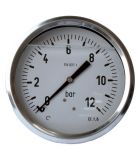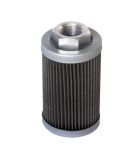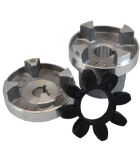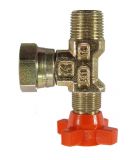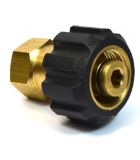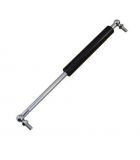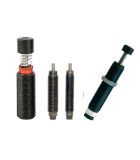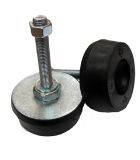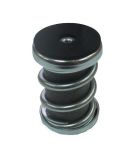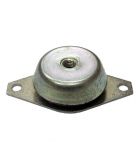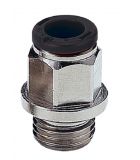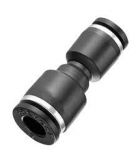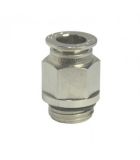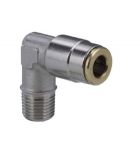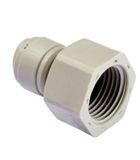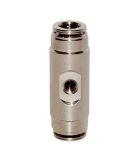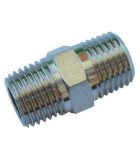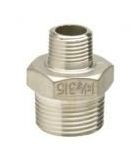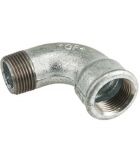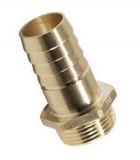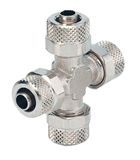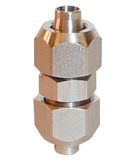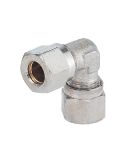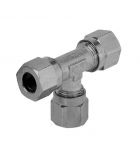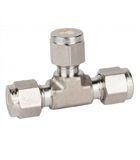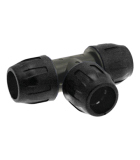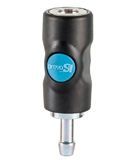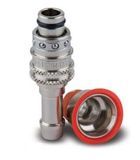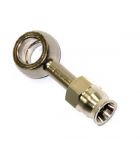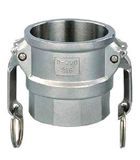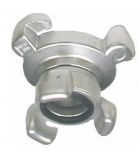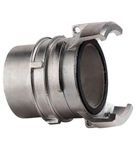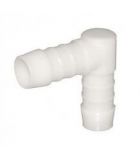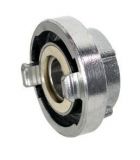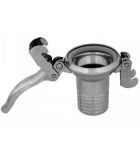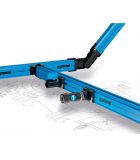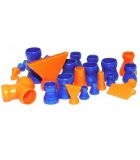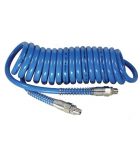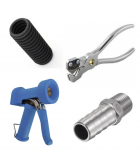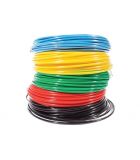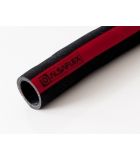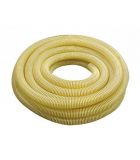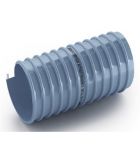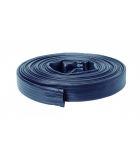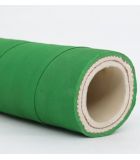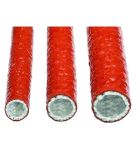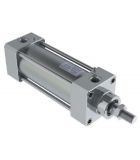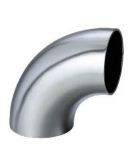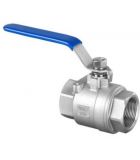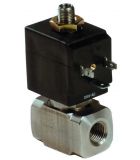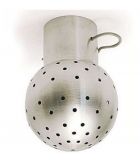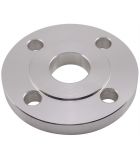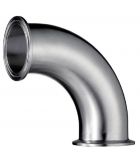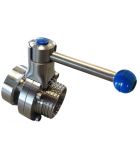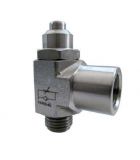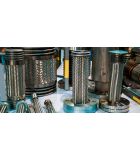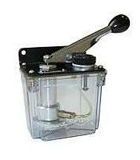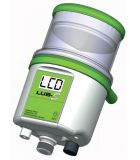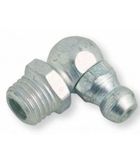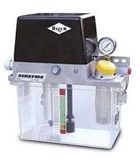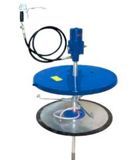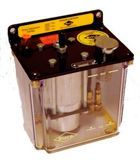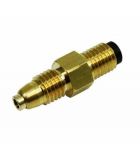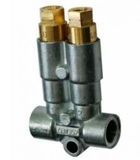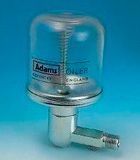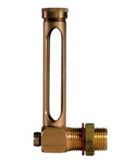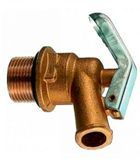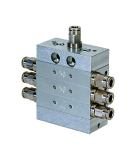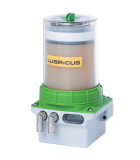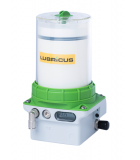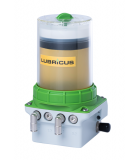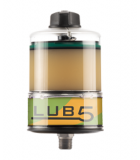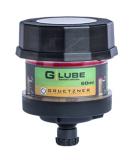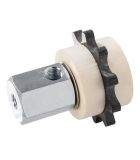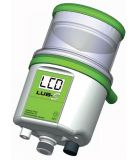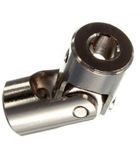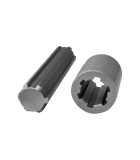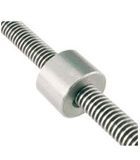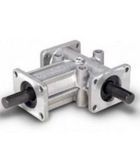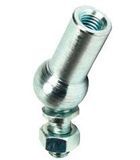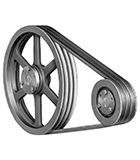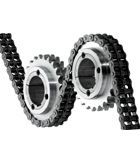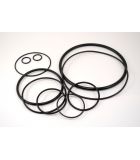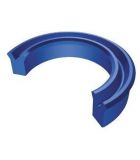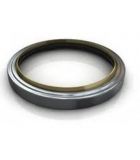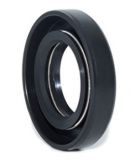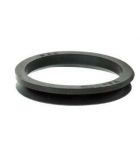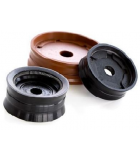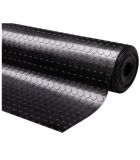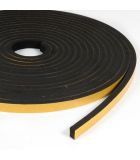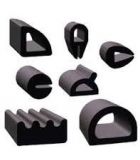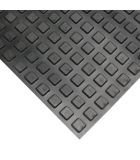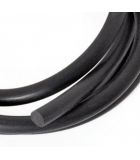COMPRESSED AIR TREATMENT SYSTEMS
Subcategories
-
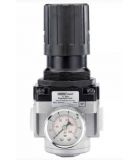
COMPRESSED AIR PRESSURE REGULATOR
<h2>Compressed air pressure regulator</h2><p> A pressure regulator is a device that aims to control the inlet or outlet pressure of compressed air from a machinery or installation, such as an air compressor, for example. In industries, it is common for advanced compressed air systems to be used to carry out many of the demanding tasks and processes they face.</p><p> The compressed air regulator is the device that is responsible for providing greater or lesser air pressure to a pneumatic system or installation. An air pressure regulator is installed in pneumatic systems to control the pressure of compressed air, playing a fundamental role in industrial processes. Depending on their use, they serve to regulate or limit the pressure of compressed air, protecting the different components of pneumatic machinery, such as valves, cylinders and hoses, among others.</p><p> An air pressure regulator works by adjusting the pressure of compressed air to values set by the user. A pressure regulator is used to control the pressure of the line, depending on the pressure of the inlet compressed air, as well as to ensure that the working pressure of the compressed air in the machinery is as defined by its manufacturer.</p><h3> Types of regulators</h3><p> There are two basic types of air pressure regulator in a compressor system, the pressure-reducing membrane regulator (normally open) and the backpressure regulator (normally closed).</p><p> <strong>1.- Pressure reducing membrane regulator</strong> . Its function is to maintain the outlet pressure constant, even if the inlet pressure varies. This regulator allows the compressed air to pass directly to the outlet, having the passage restricted, but not completely blocked, so it is normally open. The operation of a membrane air pressure regulator, the most used by companies and industries, is relatively simple. It is about balancing the forces exerted on each side of the regulator membrane. The forces are exerted by a spring and by the compressed air itself:</p><ul style="list-style-type:disc;"><li> Dock. It is a spring compressed by an adjustable screw.</li><li> Compressed air. The pressure exerted by the air entering through the other side of the membrane.</li></ul><p> The pressure regulator is responsible for compensating these different forces that confront each other in order to control the pressure obtained by the device.</p><p> 2.- <strong>Backpressure regulator.</strong> The back pressure regulator regulates the inlet pressure. The usual thing is to install it at the end of a line. The pressure of the compressed air is regulated by means of a sealing disc that exerts a tension regulated by a spring with an adjustment screw, which plays a fundamental role in this type of regulators. The increase in pressure in the inlet compressed air has to overcome the tension of the spring pressure, which is why it is said to be normally closed. The outlet pressure does not remain constant and depends on possible variations in the inlet pressure.</p><p> The main advantages provided by an air pressure regulator are:</p><ul style="list-style-type:disc;"><li> Extends the life of the machinery. An air pressure regulator is responsible for keeping the working pressure balanced within a compressed air system. With optimal operation, this component prevents the machines from deteriorating and their useful life cycle is much longer. It is important to remember that all the elements of a pneumatic circuit, such as valves, cylinders, hoses or filters, have a maximum pressure limit that they can withstand. Likewise, pneumatic machines and tools have a working pressure defined by the manufacturer. If the working pressure limits are exceeded, premature wear and breakdowns will occur. The air pressure regulator guarantees that the pressure that these components can withstand is not exceeded, ensuring that their durability over time is greater.</li><li> Offers greater control over pressure The main objective of these devices is to control the inlet or outlet pressure. For example, in a compressed air installation, the pressure regulator allows the pressure of the output compressed air to be adjusted, adjusting its value to the needs of the installation and preventing the general pressure of the installation and the working pressure of the compressors from are higher than those strictly necessary, since each bar that reduces the working pressure will reduce the electrical consumption of the compressors by 7%.</li><li> Facilitates operations with industrial machinery. Thanks to air pressure regulators, it is much easier and safer to work with pneumatic compressed air systems. Compressors are capable of generating compressed air at high pressures, so regulators play a key role in adjusting pressure to control operations and increase user safety.</li><li> Reduce costs. As indicated before, the compressed air pressure regulator allows you to adjust the air outlet pressure to have the most appropriate pressure for each process or task. This allows consumption to be reduced by avoiding using more pressure than necessary. With a regulator with high pressure control, a precise adjustment can be made, so electrical consumption can be optimized, reducing energy expenditure.</li><li> Simple maintenance. The maintenance necessary to ensure the proper functioning of an air regulator is very simple. Disassembling, checking, cleaning and reassembling these elements is a simple process that does not require much time. In addition, this time invested will save money by increasing the useful life of the air pressure regulator itself. Scheduled preventive maintenance should be a priority to ensure that the air pressure regulator is functioning properly and ensures that the air pressure supported by components and machinery is appropriate.</li></ul> -
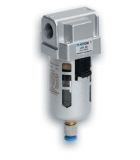
COMPRESSED AIR FILTERS
<h2>Submicron compressed air filters. Buy online at the best price</h2><p> Air filters are one of the essential elements in the treatment of industrial compressed air and must be cared for with special care. Its mission is to clean the compressed air of any impurities it may have. The compressed air generated by the compressor passes through the industrial air filter and the solid particles are retained by the different layers that form the filter, while the water droplets received by the filter are eliminated by the purging devices located at the bottom. of the filter.</p><p> One cubic meter of compressed air contains more than one hundred million dirt particles, considerable amounts of water and oil, viruses and bacteria, and even particles of heavy metals such as lead, cadmium and mercury. If the compressed air is not filtered, the trouble-free operation of system components such as valves or cylinders cannot be guaranteed in the medium or long term. For example, poorly treated compressed air can contaminate control valves and cause seals to swell and wear prematurely.</p><p> Filters play an important role in the compressed air treatment process. Depending on the application, strict purity standards require the removal of a wide variety of contaminants, including hydrocarbon aerosols and vapors.</p><p> Impurities found in compressed air can come from different sources. With the sucked air, dust or pollen existing in the ambient air can penetrate, while a tank or the pipes of the general network that corrode over time can contribute harmful particles and contaminants to the already compressed air. Aerosols and oil vapors are due in most installations to the use of lubricated compressors and must be filtered before final use.</p><p> In urban ambient air and in industrial areas there is also an average concentration of hydrocarbons between 0.03 and 0.10 mg/m3, considering an average value of 0.05 mg/m3, so there will be hydrocarbons in the air. aspirated by the compressors and therefore will also be found in the compressed air, even if the compressors are oil-free.</p><p> Depending on the compressed air applications, there are different requirements for its purity. The presence of contaminants must be limited, and cannot exceed acceptable levels, depending on the application, to avoid damage to equipment or production processes.</p><p> In compressed air filtration systems we have verified installation errors on numerous occasions, such as incorrectly mounted filters, incorrectly sized filters, or filters installed in the wrong place. The user of a compressed air installation must understand the importance of placing the appropriate filters in their installation. A poorly designed or poorly installed filtration system can cause costs and technical problems, such as excessive pressure drops or rapid saturation of the filter elements.</p> -
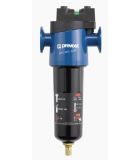
PREVOST SUBMICRONIC COMPRESSED AIR FILTERS
<h2>Submicron compressed air filters</h2><p> Air filters are one of the essential elements in the treatment of industrial compressed air and must be cared for with special care. Its mission is to clean the compressed air of any impurities it may have. The compressed air generated by the compressor passes through the industrial air filter and the solid particles are retained by the different layers that form the filter, while the water droplets received by the filter are eliminated by the purging devices located at the bottom. of the filter.</p><p> One cubic meter of compressed air contains more than one hundred million dirt particles, considerable amounts of water and oil, viruses and bacteria, and even particles of heavy metals such as lead, cadmium and mercury. If the compressed air is not filtered, the trouble-free operation of system components such as valves or cylinders cannot be guaranteed in the medium or long term. For example, poorly treated compressed air can contaminate control valves and cause seals to swell and wear prematurely.</p><p> Filters play an important role in the compressed air treatment process. Depending on the application, strict purity standards require the removal of a wide variety of contaminants, including hydrocarbon aerosols and vapors.</p><p> Impurities found in compressed air can come from different sources. With the sucked air, dust or pollen existing in the ambient air can penetrate, while a tank or the pipes of the general network that corrode over time can contribute harmful particles and contaminants to the already compressed air. Aerosols and oil vapors are due in most installations to the use of lubricated compressors and must be filtered before final use.</p><p> In urban ambient air and in industrial areas there is also an average concentration of hydrocarbons between 0.03 and 0.10 mg/m3, considering an average value of 0.05 mg/m3, so there will be hydrocarbons in the air. aspirated by the compressors and therefore will also be found in the compressed air, even if the compressors are oil-free.</p><p> Depending on the compressed air applications, there are different requirements for its purity. The presence of contaminants must be limited, and cannot exceed acceptable levels, depending on the application, to avoid damage to equipment or production processes. In compressed air filtration systems we have verified installation errors on numerous occasions, such as incorrectly mounted filters, incorrectly sized filters, or filters installed in the wrong place. The user of a compressed air installation must understand the importance of placing the appropriate filters in their installation.</p><p> A poorly designed or poorly installed filtration system can cause costs and technical problems, such as excessive pressure drops or rapid saturation of the filter elements.</p><h3> Types of filters</h3><p> There are different types of filters depending on the type of filtration, depending on the materials and structure of the filter elements. Within the different categories of filters for compressed air are the following: ceramic filters, water separating filters, coalescing filters of different degrees of filtration, active carbon filters and towers, and sterile and steam filters.</p><ol><li> Ceramic Filters: Ceramic filters are used with reciprocating piston compressors, where there is poor compressed air quality. The filter elements are ceramic spark plugs and their filtering capacity is greater than 5 microns. Since the introduction of rotary screw compressors years ago, replacing reciprocating piston compressors, this type of filter has been disappearing from compressor rooms.</li><li> Water Separator Filters: Water separator filters are used to eliminate large amounts of condensate, such as that generated in the aftercoolers of compressors caused by the cooling of compressed air. These filters in most cases do not have filter elements, the condensate being separated mechanically by circulating the compressed air through a centrifugal diffuser that causes its precipitation at the base of the filter to be eliminated later.</li><li> Coalescing Filters: Coalescing filters are mainly used to remove particles and hydrocarbons according to their filtration degree, although they also remove part of the humidity from compressed air. Its particle filtering capacity ranges from 5 microns to 0.01 microns, and for hydrocarbons from 3 mg/m 3 to 0.005 mg/m 3. The filter elements are made of borosilicate microfiber and polyester materials. In coalescing filters, particles, water and hydrocarbons adhere by coalescence to the fiber of the filter element, forming increasingly larger droplets that fall towards the base of the filter, being subsequently eliminated. When the filter element becomes saturated it must be replaced to avoid pressure losses that cause greater energy consumption.</li><li> Activated Carbon Filters and Towers: activated carbon filters and towers are used for the elimination of hydrocarbon vapors and odors. Its filtration capacity is for a residual oil content of up to 0.003 mg/m 3. Activated carbon filters and towers must be preceded by coalescing filters to prevent them from becoming saturated quickly. The filter elements have active carbon on their surface to retain and eliminate hydrocarbons from compressed air, while the towers have active carbon inside as an adsorbent material. In the latter, a rear particle filter must always be installed to retain any possible activated carbon dust that could come out with the compressed air.</li></ol><p> For the recycling and evacuation of accumulated elements and water, purges are used. These are the types:</p><ul style="list-style-type:disc;"><li> Manual: Condensate is drained manually by opening the petcock located at the base of the housing. This type of purge is usually mounted on filters located in points where moisture should not reach due to the previous treatment, such as activated carbon filters or particle post-filters, which is why they require regular checks for the existence of condensate.</li><li> Semi-automatic: this type of drain is normally closed when the filter is under pressure. When the pressure in the filter is reduced to ambient pressure, the filter opens, purging the condensate. This type of purge is usually installed in filters located in the installation intakes or in the purge downpipes of the general network.</li><li> Buoy or float: this type of drain is automatic and acts mechanically. As there is condensate at the base of the filter, the buoy or float rises, allowing the condensate to escape, creating a rear seat to close it. The drawback of this type of filter is that if there are particles or dirt at the base of the housing, the closure will not occur correctly, causing compressed air leaks with consequent losses.</li><li> Timed: this type of drain is automatic, requires electrical power and acts on a timed basis. Timing is carried out by regulating the opening time of the purge and the time interval between purges. The problem with this type of purge is that it is difficult for the purge to coincide with the actual moment in which it should occur, so usually either all the condensate is not purged, or what we will have are losses due to compressed air leaks if we want to ensure a complete purge.</li><li> Capacitive: this type of drain is automatic, with a drain system through electronic level regulation, requiring electrical power. This purge system is the most effective in preventing losses of compressed air. These drains have a capacitive level sensor inside a container where the condensate is deposited. When the container is filled, the level sensor sends a signal to the electronic controller to open the outlet pipe and evacuate the condensate. Some capacitive purge models incorporate a management system that monitors the useful life of the filter element.</li></ul> -
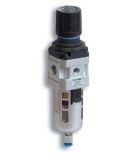
COMPRESSED AIR FILTER-REGULATORS
<h2>Compressed air filters-regulators-lubricators.</h2><h3> Compressed air filters</h3><p> Air filters are one of the essential elements in the treatment of industrial compressed air and must be cared for with special care. Its mission is to clean the compressed air of any impurities it may have. The compressed air generated by the compressor passes through the industrial air filter and the solid particles are retained by the different layers that form the filter, while the water droplets received by the filter are eliminated by the purging devices located at the bottom. of the filter.</p><p> Impurities found in compressed air can come from different sources. With the sucked air, dust or pollen existing in the ambient air can penetrate, while a tank or the pipes of the general network that corrode over time can contribute harmful particles and contaminants to the already compressed air.</p><p> Aerosols and oil vapors are due in most installations to the use of lubricated compressors and must be filtered before final use. In urban ambient air and in industrial areas there is also an average concentration of hydrocarbons between 0.03 and 0.10 mg/m3, considering an average value of 0.05 mg/m3, so there will be hydrocarbons in the air. aspirated by the compressors and therefore will also be found in the compressed air, even if the compressors are oil-free.</p><p> Depending on the compressed air applications, there are different requirements for its purity. The presence of contaminants must be limited, and cannot exceed acceptable levels, depending on the application, to avoid damage to equipment or production processes. In compressed air filtration systems we have verified installation errors on numerous occasions, such as incorrectly mounted filters, incorrectly sized filters, or filters installed in the wrong place.</p><p> The user of a compressed air installation must understand the importance of placing the appropriate filters in their installation. A poorly designed or poorly installed filtration system can cause costs and technical problems, such as excessive pressure drops or rapid saturation of the filter elements.</p><h3> Compressed Air Regulators</h3><p> A pressure regulator is a device that aims to control the inlet or outlet pressure of compressed air from a machinery or installation, such as an air compressor, for example. In industries, it is common for advanced compressed air systems to be used to carry out many of the demanding tasks and processes they face. The compressed air regulator is the device that is responsible for providing greater or lesser air pressure to a pneumatic system or installation.</p><p> An air pressure regulator is installed in pneumatic systems to control the pressure of compressed air, playing a fundamental role in industrial processes. Depending on their use, they serve to regulate or limit the pressure of compressed air, protecting the different components of pneumatic machinery, such as valves, cylinders and hoses, among others.</p><p> An air pressure regulator works by adjusting the pressure of compressed air to values set by the user. A pressure regulator is used to control the line pressure, depending on the inlet compressed air pressure, as well as to ensure that the working pressure of the compressed air in the machinery is as defined by its manufacturer.</p><p> There are two basic types of air pressure regulator in a compressor system, the pressure-reducing membrane regulator (normally open) and the backpressure regulator (normally closed).</p><p> <strong>1.- Pressure reducing membrane regulator</strong> . Its function is to maintain the outlet pressure constant, even if the inlet pressure varies. This regulator allows the compressed air to pass directly to the outlet, having the passage restricted, but not completely blocked, so it is normally open. The operation of a membrane air pressure regulator, the most used by companies and industries, is relatively simple. It is about balancing the forces exerted on each side of the regulator membrane. The forces are exerted by a spring and by the compressed air itself:</p><ul style="list-style-type:disc;"><li> Dock. It is a spring compressed by an adjustable screw.</li><li> Compressed air. The pressure exerted by the air entering through the other side of the membrane.</li></ul><p> The pressure regulator is responsible for compensating these different forces that confront each other in order to control the pressure obtained by the device. Back pressure regulator.</p><p> <strong>2.- The backpressure regulator regulates the inlet pressure</strong> . The usual thing is to install it at the end of a line. The pressure of the compressed air is regulated by means of a sealing disc that exerts a tension regulated by a spring with an adjustment screw, which plays a fundamental role in this type of regulators. The increase in pressure in the inlet compressed air has to overcome the tension of the spring pressure, which is why it is said to be normally closed. The outlet pressure does not remain constant and depends on possible variations in the inlet pressure.</p><h4> Advantages of a pressure regulator</h4><p> The main advantages provided by an air pressure regulator are:</p><p> <strong>Extends the life of the machinery</strong> . An air pressure regulator is responsible for keeping the working pressure balanced within a compressed air system. With optimal operation, this component prevents the machines from deteriorating and their useful life cycle is much longer. It is important to remember that all the elements of a pneumatic circuit, such as valves, cylinders, hoses or filters, have a maximum pressure limit they can withstand. Likewise, pneumatic machines and tools have a working pressure defined by the manufacturer. If the working pressure limits are exceeded, premature wear and breakdowns will occur. The air pressure regulator guarantees that the pressure that these components can withstand is not exceeded, ensuring that their durability over time is greater.</p><p> <strong>Offers greater control over pressure</strong> . The main objective of these devices is to control the inlet or outlet pressure. For example, in a compressed air installation, the pressure regulator allows the pressure of the output compressed air to be adjusted, adjusting its value to the needs of the installation and preventing the general pressure of the installation and the working pressure of the compressors from are higher than those strictly necessary, since each bar that reduces the working pressure will reduce the electrical consumption of the compressors by 7%.</p><p> <strong>Facilitates operations with industrial machinery.</strong> Thanks to air pressure regulators, it is much easier and safer to work with pneumatic compressed air systems. Compressors are capable of generating compressed air at high pressures, so regulators play a key role in adjusting pressure to control operations and increase user safety.</p><p> <strong>Reduce costs.</strong> As indicated before, the compressed air pressure regulator allows you to adjust the air outlet pressure to have the most appropriate pressure for each process or task. This allows consumption to be reduced by avoiding using more pressure than necessary. With a regulator with high pressure control, a precise adjustment can be made, so electrical consumption can be optimized, reducing energy expenditure.</p><p> <strong>Simple maintenance.</strong> The maintenance necessary to ensure the proper functioning of an air regulator is very simple. Disassembling, checking, cleaning and reassembling these elements is a simple process that does not require much time. In addition, this time invested will save money by increasing the useful life of the air pressure regulator itself. Scheduled preventive maintenance should be a priority to ensure that the air pressure regulator is functioning properly and ensures that the air pressure supported by components and machinery is appropriate.</p> -
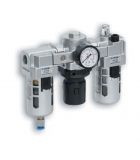
COMPRESSED AIR LUBRICANT REGULATOR FILTER
<h2>Compressed air filters-regulators-lubricators.</h2><h3> Compressed air filters</h3><p> Air filters are one of the essential elements in the treatment of industrial compressed air and must be cared for with special care. Its mission is to clean the compressed air of any impurities it may have. The compressed air generated by the compressor passes through the industrial air filter and the solid particles are retained by the different layers that make up the filter, while the water droplets received by the filter are eliminated by the purging devices located at the bottom. of the filter.</p><p> Impurities found in compressed air can come from different sources. With the sucked air, dust or pollen existing in the ambient air can penetrate, while a tank or the pipes of the general network that corrode over time can contribute harmful particles and contaminants to the already compressed air.</p><p> Aerosols and oil vapors are due in most installations to the use of lubricated compressors and must be filtered before final use. In urban ambient air and in industrial areas there is also an average concentration of hydrocarbons between 0.03 and 0.10 mg/m3, considering an average value of 0.05 mg/m3, so there will be hydrocarbons in the air. aspirated by the compressors and therefore will also be found in the compressed air, even if the compressors are oil-free.</p><p> Depending on the compressed air applications, there are different requirements for its purity. The presence of contaminants must be limited, and cannot exceed acceptable levels, depending on the application, to avoid damage to equipment or production processes. In compressed air filtration systems we have verified installation errors on numerous occasions, such as incorrectly mounted filters, incorrectly sized filters, or filters installed in the wrong place.</p><p> The user of a compressed air installation must understand the importance of placing the appropriate filters in their installation. A poorly designed or poorly installed filtration system can cause costs and technical problems, such as excessive pressure drops or rapid saturation of the filter elements.</p><h3> Compressed Air Regulators</h3><p> A pressure regulator is a device that aims to control the inlet or outlet pressure of compressed air from a machinery or installation, such as an air compressor, for example. In industries, it is common for advanced compressed air systems to be used to carry out many of the demanding tasks and processes they face. The compressed air regulator is the device that is responsible for providing greater or lesser air pressure to a pneumatic system or installation.</p><p> An air pressure regulator is installed in pneumatic systems to control the pressure of compressed air, playing a fundamental role in industrial processes. Depending on their use, they serve to regulate or limit the pressure of compressed air, protecting the different components of pneumatic machinery, such as valves, cylinders and hoses, among others.</p><p> An air pressure regulator works by adjusting the pressure of compressed air to values set by the user. A pressure regulator is used to control the line pressure, depending on the inlet compressed air pressure, as well as to ensure that the working pressure of the compressed air in the machinery is as defined by its manufacturer.</p><p> There are two basic types of air pressure regulator in a compressor system, the pressure-reducing membrane regulator (normally open) and the backpressure regulator (normally closed).</p><p> <strong>1.- Pressure reducing membrane regulator</strong> . Its function is to maintain the outlet pressure constant, even if the inlet pressure varies. This regulator allows the compressed air to pass directly to the outlet, having the passage restricted, but not completely blocked, so it is normally open. The operation of a membrane air pressure regulator, the most used by companies and industries, is relatively simple. It is about balancing the forces exerted on each side of the regulator membrane. The forces are exerted by a spring and by the compressed air itself:</p><ul style="list-style-type:disc;"><li> Dock. It is a spring compressed by an adjustable screw.</li><li> Compressed air. The pressure exerted by the air entering through the other side of the membrane.</li></ul><p> The pressure regulator is responsible for compensating these different forces that confront each other in order to control the pressure obtained by the device. Back pressure regulator.</p><p> <strong>2.- The backpressure regulator regulates the inlet pressure</strong> . The usual thing is to install it at the end of a line. The pressure of the compressed air is regulated by means of a sealing disc that exerts a tension regulated by a spring with an adjustment screw, which plays a fundamental role in this type of regulators. The increase in pressure in the inlet compressed air has to overcome the tension of the spring pressure, which is why it is said to be normally closed. The outlet pressure does not remain constant and depends on possible variations in the inlet pressure.</p><h4> Advantages of a pressure regulator</h4><p> The main advantages provided by an air pressure regulator are:</p><p> <strong>Extends the life of the machinery</strong> . An air pressure regulator is responsible for keeping the working pressure balanced within a compressed air system. With optimal operation, this component prevents the machines from deteriorating and their useful life cycle is much longer. It is important to remember that all the elements of a pneumatic circuit, such as valves, cylinders, hoses or filters, have a maximum pressure limit they can withstand. Likewise, pneumatic machines and tools have a working pressure defined by the manufacturer. If the working pressure limits are exceeded, premature wear and breakdowns will occur. The air pressure regulator guarantees that the pressure that these components can withstand is not exceeded, ensuring that their durability over time is greater.</p><p> <strong>Offers greater control over pressure</strong> . The main objective of these devices is to control the inlet or outlet pressure. For example, in a compressed air installation, the pressure regulator allows the pressure of the output compressed air to be adjusted, adjusting its value to the needs of the installation and preventing the general pressure of the installation and the working pressure of the compressors from are higher than those strictly necessary, since each bar that reduces the working pressure will reduce the electrical consumption of the compressors by 7%.</p><p> <strong>Facilitates operations with industrial machinery.</strong> Thanks to air pressure regulators, it is much easier and safer to work with pneumatic compressed air systems. Compressors are capable of generating compressed air at high pressures, so regulators play a key role in adjusting pressure to control operations and increase user safety.</p><p> <strong>Reduce costs.</strong> As indicated before, the compressed air pressure regulator allows you to adjust the air outlet pressure to have the most appropriate pressure for each process or task. This allows consumption to be reduced by avoiding using more pressure than necessary. With a regulator with high pressure control, a precise adjustment can be made, so electrical consumption can be optimized, reducing energy expenditure.</p><p> <strong>Simple maintenance.</strong> The maintenance necessary to ensure the proper functioning of an air regulator is very simple. Disassembling, checking, cleaning and reassembling these elements is a simple process that does not require much time. In addition, this time invested will save money by increasing the useful life of the air pressure regulator itself. Scheduled preventive maintenance should be a priority to ensure that the air pressure regulator is functioning properly and ensures that the air pressure supported by components and machinery is appropriate.</p><h3> Compressed air lubricators</h3><p> The compressed air lubricator is an element that is inserted into the lines where there is compressed air pressure, with the objective of injecting into the air stream, a specific amount of oil intended to lubricate the tool or pneumatic equipment installed from the point of lubricator application. This applied oil is deposited in a nebulized manner by the air pressure itself, like a cloud of microparticles.</p><p> This small mist makes it possible to Lubricationall systems, pneumatic cylinders, pneumatic valves and distributors, pneumatic tools and all peripherals associated with the compressed air line. This works based on the “venturi” principle, reducing the flow area, increasing the speed of the fluid and spraying or nebulizing a drop of oil so that it is distributed uniformly to the equipment connected to the air line. VG-32 oil is recommended for this use and has anticorrosive property,</p><p> The lubricator has a pre-established direction of passage already indicated on each lubricator. It also has a maximum and minimum oil indicator, which we can fill, using a filler cap, even when there is pressure in the comprimido.Posee air line. It also has an oil inlet quantity regulator, using a screw, which we will regulate to the desired way.</p><p> These equipment will extend the useful life of the lubricated elements. It is usually coupled to filters and pressure regulators. It is common to find them in all compressed air networks, forming a set with filters and regulators called FRL. They must always be placed after the filter or regulator to prevent moisture from entering the lubricator and the formation of an emulsion.</p><p> Pneumatic lubricators are safe, do not have explosive characteristics or produce excessive heat. They are used in practically all types of industries, where automation is present.</p> -
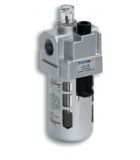
COMPRESSED AIR LUBRICATORS
<h2>Compressed air pneumatic lubricators. Buy online at the best price</h2><p> <strong>The compressed air lubricator</strong> is an element that is inserted into the lines where there is compressed air pressure, with the objective of injecting into the air stream, a specific amount of oil intended to lubricate the tool or pneumatic equipment installed from the point of lubricator application. This applied oil is deposited in a nebulized manner by the air pressure itself, like a cloud of microparticles.</p><p> This small mist makes it possible to Lubricationall systems, pneumatic cylinders, pneumatic valves and distributors, pneumatic tools and all peripherals associated with the compressed air line. This works based on the “venturi” principle, reducing the flow area, increasing the speed of the fluid and spraying or nebulizing a drop of oil so that it is distributed uniformly to the equipment connected to the air line. VG-32 oil is recommended for this use and has anticorrosive property,</p><p> <strong>The lubricator</strong> has a pre-established direction of passage already indicated on each lubricator. It also has a maximum and minimum oil indicator, which we can fill, using a filler cap, even when there is pressure in the comprimido.Posee air line. It also has an oil inlet quantity regulator, using a screw, which we will regulate to the desired way.</p><p> These equipment will extend the useful life of the lubricated elements. It is usually coupled to filters and pressure regulators. It is common to find them in all compressed air networks, forming a set with filters and regulators called FRL. They must always be placed after the filter or regulator to prevent moisture from entering the lubricator and the formation of an emulsion.</p><p> <strong>Pneumatic lubricators</strong> are safe, do not have explosive characteristics or produce excessive heat. They are used in practically all types of industries, where automation is present.</p> -
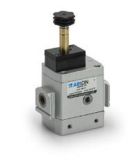
PNEUMATIC VALVE PROGRESSIVE START
<h2>Progressive start valves for pneumatic installations.</h2><p> The progressive start valves are a pneumatic component that allows air to enter the circuit gradually, thus avoiding forced openings of excessive pressure. A sophisticated internal valve system allows two separate stages of operation. During the first stage, an amount of air leaves the soft-start valve that can be regulated by means of a pin.</p><p> The second stage is started when the downstream pressure again reaches 40 to 60% of the upstream pressure, during which the full port defect is reached. When the mechanism is deactivated, the air flow is cut off and the downstream circuit is relieved. The soft start valve is especially useful in machines where it is important to prevent the actuators or peripherals from moving quickly and uncontrollably, or where, for safety reasons, the air intake must be gentle and gradual.</p><p> However, if there is a significant leak in the downstream system, it may never be possible to achieve the pressure needed to fully open the valve. In the event that it is necessary to quickly bleed the descent circuit, it is enough to intervene on the control valve, which interrupts the air flow in the duct, causing the valve to close and the descent circuit to bleed.</p><p> In this way, the soft starter performs the double function of positioning the actuators, eliminating the risk of sudden kickbacks and safety valves by quickly unloading, using the remote control, the circuit served. To set the pressure setting time, the built-in flow regulator is used.</p><p> The pressures supported by the progressive start valve are the industry standard 10 bar, and the minimum 3 bar. We can have flow rates from 900 l/min to 4800 l7 min. Progressive start valves are used in all types of industry where the safety of any device or machine wants to be guaranteed by very sudden cylinder movements, which can cause a lot of damage.</p><p> Pneumatic soft start valves are safe, they do not produce excessive heat. The compressed air used to move the pneumatic cylinders does not generate water hammer, which reduces breakdowns or damage to the equipment.</p> -
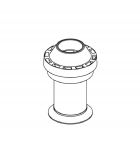
SPARE PARTS AND ACCESSORIES
-
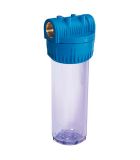
WATER FILTER
<h2>Water filters for compressed air systems</h2><p> A water filter is a device that eliminates impurities from water by reducing contamination through a fine physical barrier, such as filter elements or cartridges. It also serves to filter contaminating components that water may contain, such as chlorine particles. active, organochlorine and organic compounds, iron, excess calcium and magnesium salts, cations and anions of heavy metals, viruses and dangerous bacteria.</p><h3> Mechanical water filter</h3><p> The basic idea of mechanical filtration is to physically remove sediment, dirt or any particles in the water, using a physical barrier. A mechanical filter can range from a basic mesh for filtering out large debris to a ceramic filter that has an extremely complex pore structure for ultra-fine filtration of pathogenic organisms.</p><p> A filter that uses mechanical filtration will typically receive a micron rating which indicates how effective the filter is in terms of the size of particles it is able to retain.</p><p> The most common classifications include:</p><p> <strong>Activated carbon filter:</strong> It is a filter in which carbon works as an absorber of harmful particles. They are very common on the market, low cost and are found in presentations designed for easy installation in home laundry rooms. They can be found from 80 or 100 soles. It is also widely used in the production of packaged and alcoholic beverages because it eliminates bad odors, but not metals.</p><p> <strong>Ceramic filter:</strong> It is a type of filter that works through micropores. Its great advantage is its long useful life, but like other filters, it does not eliminate chemical substances.</p><h3> Water filter parts:</h3><ul><li> The head and nut made of polypropylene.</li><li> The glass is transparent in <span translate="no">SAN</span></li><li> The filter element, depending on the filtration level, can be:<ul style="list-style-type:square;padding-left:40px;"><li> Washable 60 micron plastic mesh cartridge.</li><li> 20 micron wound polypropylene cartridge.</li><li> 144 micron stainless mesh cartridge.</li><li> Active carbon cartridge 10 microns</li></ul></li></ul>
Compressed air treatment systems
In many industries, compressed air requires additional treatment once compression has been performed. Compressed air contains liquid and solid impurities. The first are mainly traces of oil from the compressor and water vapor. The second are formed by the vacuumed dust and solid particles released from the installation due to oxidation effects. Both reduce the useful life of pneumatic equipment.
Air as an energy medium is available almost unlimitedly throughout the world, however it requires different degrees of quality, depending on its use. The air is different in different climate zones, due to pollution produced by traffic, industry, agriculture and other factors. This aspect must be taken into account when treating compressed air.
With proper treatment of compressed air, machine breakdowns and downtime can be significantly reduced. Also, as a process medium, compressed air must be adequately treated. The quality of compressed air is governed by the following requirements.
The ISO8573-1 standard determines the amount of dirt permissible per cubic meter of compressed air. Solid particles, water and oil are the 3 main types of dirt. Consequently, different processes overlap in the treatment of compressed air. The load of germs and bacteria also deserves special attention. The DIN-ISO 8573-1 standard does not define limits for germs or microorganisms.
There are a wide variety of compressed air auxiliary products that help treat air, including air dryers, filters, purges, water separators, lubricators, regulators, reboilers or reservoirs.
Compressed air is used in a wide range of industries and in many different ways. The requirements regarding its quality and purity vary according to the sector where it will be used.
The standards applied in an industry such as textiles may vary completely from those applied in the food or medical industries, which require completely oil-free compressed air.

